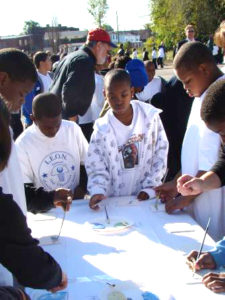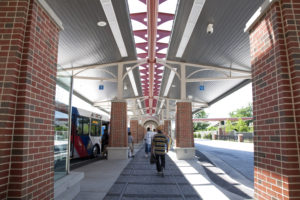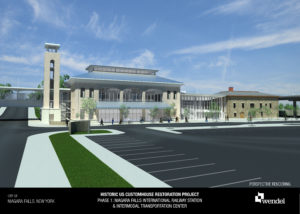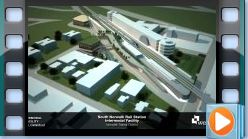
Fully integrated intermodal transit centers enhance the quality of life in the communities they serve by offering as many transportation modes as possible and spurring economic development and infrastructure growth. In order to achieve this goal, it is essential their design is an appropriate balance of Science and Art.
The Science
The science of an intermodal center is primarily the engineering and technical design and includes the following:
Pedestrian Safety and Walkability
Circulation patterns that minimize the number of times pedestrians cross vehicle paths.
Vehicle Type Separation
Provide separate ingress and egress points for each mode and vehicle type – local bus, intercity bus, shuttles, taxis, bicycles, Kiss and Ride, parking, and deliveries.
Vehicle Movements
Accurate horizontal (geometric) and vertical (grade) engineering so vehicles can maneuver through turns without backing up or “bottoming out” when entering or exiting the site. The use of computer design software accomplishes this during the design process. Laying out a full-size prototype with traffic cones and then driving a bus through the layout allows you to test the bus movement prior to construction.
(This is an example of using AutoTurn- the design software)
Traffic Control
Impacts to adjacent streets, roads and intersections is mitigated by separate ingress and egress points for each vehicle type, as well as appropriate traffic signage and signalization.
Signage and Wayfinding
The signage and wayfinding design enables users to find their way without having to ask for directions.
Federal Requirements
Applying the Federal Transit Administration and state environmental regulations to prevent the project from having an adverse effect on people and the environment. Federal requirements are typically referred to as “NEPA.”
The Art
The art is what makes a transit center feel and act like the “Town Center,” an integral part of the community fabric. The following examples provide examples of how this can be achieved:
Petersburg Intermodal Transit Center, Petersburg, VA

This transit center accommodates intercity and local bus carriers, paratransit vehicles, a trolley service, taxis, bicycle racks and lockers, Kiss and Ride drop-offs and on-site parking. In addition to providing state-of-the-art transit service, the community wanted the facility to provide the “Petersburg Experience” by incorporating elements of Petersburg’s rich history, thereby drawing travelers and non-travelers alike to visit.
In recognition of Petersburg being a strategic railroad center by the mid-19th century, metaphorical inlaid concrete train rails on the outside of the building and inlaid zinc train

rails inside the building are part of the facility’s wayfinding system that leads customers safely from mode to mode and throughout the building. Following these rails provides an interpretive walking experience by means of inlaid floor medallions and wall plaques that contain historical information.
Another aspect of the “art” of the facility is the inclusion of art itself. Thirty busloads of local children were invited to the site to create drawings of what they think about when they hear “public transportation.” Their artwork is displayed in the main concourse of the facility on a rotating basis.
To illustrate how transit projects enhance communities by stimulating additional development, since the transit center opened in 2011, the city opened a new library on the next block in 2014 and is currently designing a new City Hall, which will be located directly across the street. Additionally, three new apartment complexes, all within one block of the transit center, are currently in design.
Niagara Falls Intermodal Station, Niagara Falls, NY
This intermodal station, currently under construction, is located on the U.S.-Canadian border. Home to the majestic Niagara Falls, it was designed to be a focal point and impetus for tourism and future development of the commercial district, providing a state-of-the-art portal for tourists and commuters alike.

The station will be home to a new Amtrak Station and will accommodate local buses, tour/coach buses, pedestrians, bicyclists, taxis, park-and-ride users, and circulator shuttles for New York State Parks and local hotels.
The jewel that makes it a true tourism destination is the interpretive Underground Railroad museum that will be located in the historic, rehabilitated Customs House portion of the facility, as Niagara Falls was an important stop on this route to freedom for slaves on their flight to Canada.
Transforming this station into a community center is accomplished in several ways. The main lobby of the station is purposely designed and sized to accommodate large community events and social functions. Additionally, the project will have a large outdoor plaza, named “Harriet Tubman Plaza,” that will host outdoor entertainment and community events, anchored by a new amphitheater featuring a fabric canopy covered stage.
Marrying the Science and the Art
The result attained when marrying the science and art in a transit center is expressed in the timeless phrase, “The whole is greater than the sums of its parts.” A transit center that is a combination of excellent engineering and community-centric design will be a foundation for a sustainable, resilient community. Admittedly, the science and engineering portion of the equation may be easier to achieve in our current environment of scarce resources. However, the few examples contained herein inspire us that with patience, persistence, and teamwork, the art and design can successfully be added to make dynamic living places that people will wholeheartedly embrace. The result is well worth the effort.
For the full article as it appeared in BusRide Magazine, please click here: BUSRideAugust2015ArticleByWendel
Written for BusRide Magazine by:
Vice President Public Transportation, Principal

